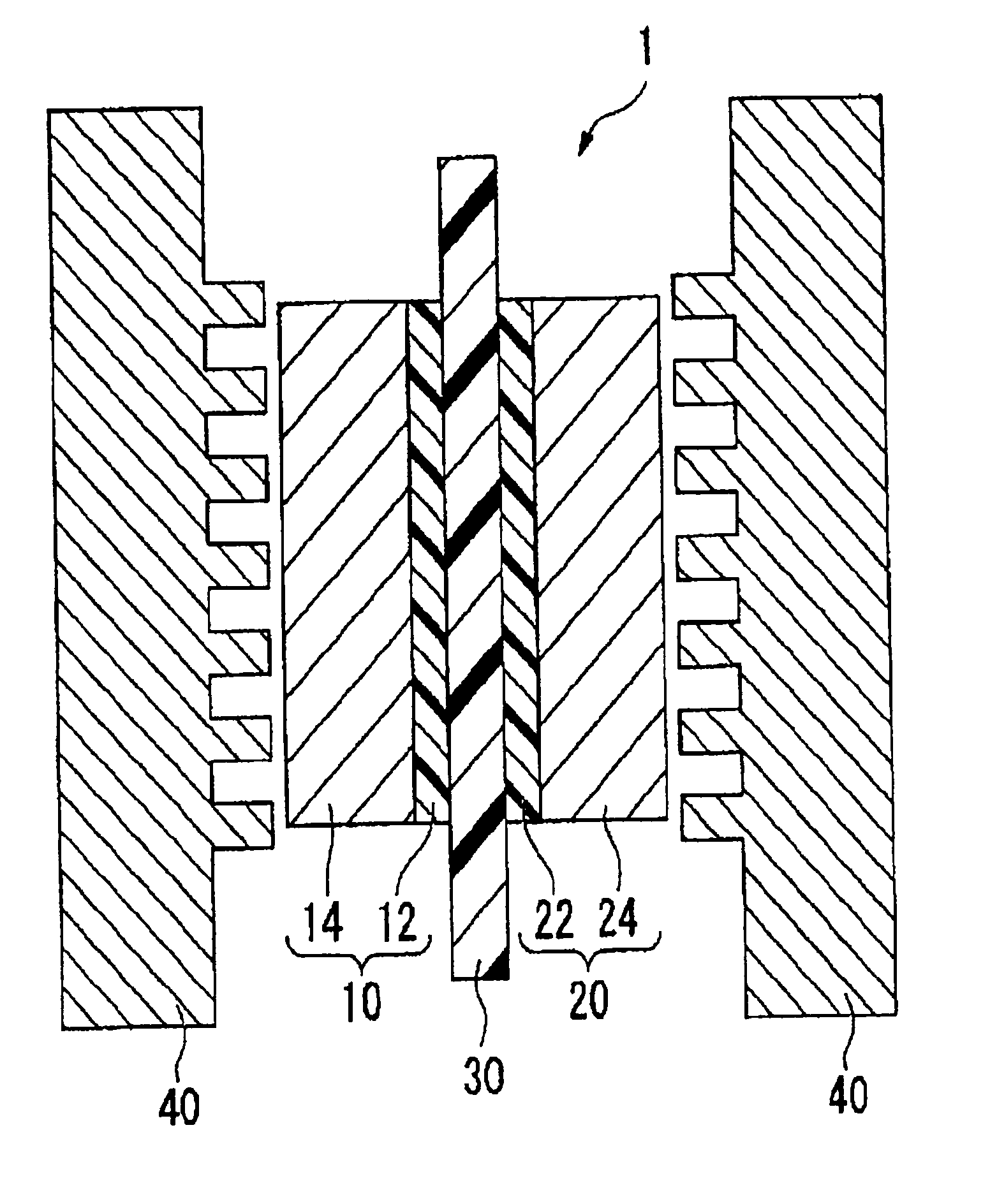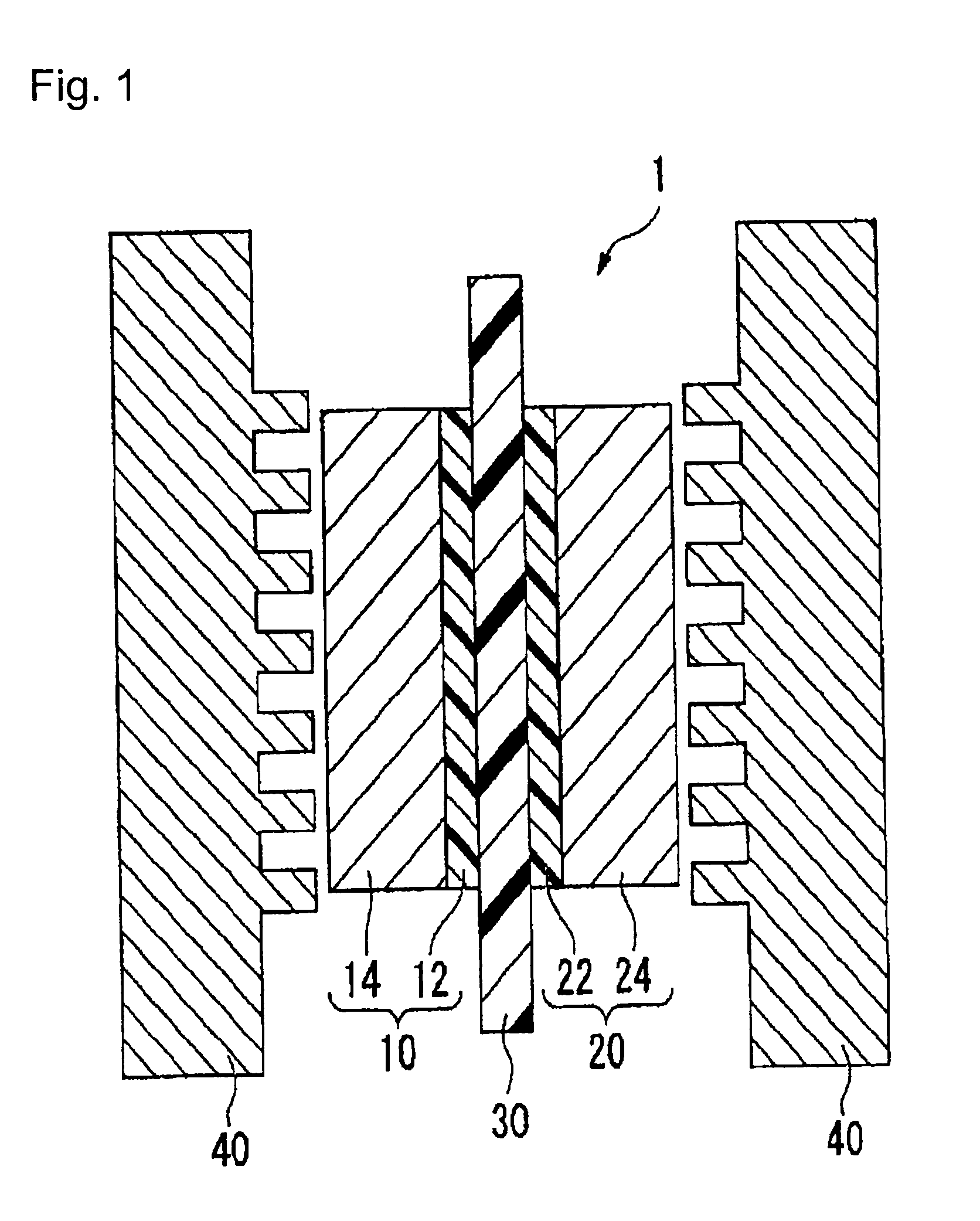Process for producing membrane/electrode assembly for polymer electrolyte fuel cell and process for producing polymer electrolyte fuel cell
a technology of electrolyte fuel cell and electrolyte, which is applied in the direction of fuel cells, sustainable manufacturing/processing, climate sustainability, etc., can solve the problems of deterioration of gas diffusion properties, insufficient adhesion between gas diffusion layer and catalyst layer, and inability to meet the requirements of the conventional process. achieve the effect of wide current density range and high output voltag
- Summary
- Abstract
- Description
- Claims
- Application Information
AI Technical Summary
Benefits of technology
Problems solved by technology
Method used
Image
Examples
first embodiment
[0033]FIG. 1 is a schematic cross-sectional drawing of the polymer electrolyte fuel cell using the membrane / electrode assembly 1 produced in the present embodiment.
[0034]The membrane / electrode assembly 1 is composed of the anode 10, cathode 20 and polymer electrolyte membrane 30 disposed between them. The anode 10 is composed of the catalyst layer 12 and the carbon fiber layer 14, and the catalyst layer 12 is adjacent to the polymer electrolyte membrane 30. The cathode 20 is composed of the catalyst layer 22 and the carbon fiber layer 24, and the catalyst layer 22 is adjacent to the polymer electrolyte membrane 30.
[0035]The membrane / electrode assembly 1 is disposed between two separators 40 each having a gas channel formed on a surface thereof to constitute the polymer electrolyte fuel cell. At that time, the carbon fiber layer 14 of the anode 10 and the carbon fiber layer 24 of the cathode 20, which are the outermost layers in the membrane / electrode assembly 1, are adjacent to the ...
second embodiment
[0105]In the present embodiment, only the cathode 20 is prepared in the same manner as in the first embodiment, and the catalyst layer 22 of the cathode 20 is bonded to the electrolyte membrane 30.
[0106]The anode 10 in the membrane / electrode assembly 1 obtained in the present embodiment has the catalyst layer 12 adjacent to the electrolyte membrane 30 and the ordinary gas diffusion layer, instead of the carbon fiber layer 14, is adjacent to the surface of the catalyst layer which is not adjacent to the electrolyte membrane 30.
[0107]Namely, the outermost layer on the cathode 20 side is the carbon fiber layer and the outermost layer on the anode side is the ordinary gas diffusion layer in the membrane / electrode assembly prepared in the present embodiment.
[0108]In the present embodiment, a method for forming the anode 10 on the surface of the electrolyte membrane 30 may be, for example, a method wherein the catalyst layer 12 is directly formed on the surface of the electrolyte membrane...
third embodiment
[0112]In the present embodiment, only the anode 10 is prepared in the same manner as in the first embodiment, and the catalyst layer 12 of the anode 10 is bonded to the electrolyte membrane 30.
[0113]The present embodiment can be carried out in the same manner as in the second embodiment except that the methods of forming the anode 10 and the cathode 20 are opposite.
[0114]In the second embodiment and third embodiment, the ordinary gas diffusion layer is provided on the outermost layer of the membrane / electrode assembly on the side where no carbon fiber layer exists (i.e., on the outermost layer on the anode 10 side in the second embodiment, or on the outermost layer on the cathode 20 side in the third embodiment), but the present invention is by no means restricted to these examples. For example, the anode 10 in the second embodiment may be comprised of only the catalyst layer 12, or the cathode 20 of the third embodiment may be comprised of only the catalyst layer 22. In this case, ...
PUM
| Property | Measurement | Unit |
|---|---|---|
| thickness | aaaaa | aaaaa |
| diameter | aaaaa | aaaaa |
| temperature | aaaaa | aaaaa |
Abstract
Description
Claims
Application Information
 Login to View More
Login to View More - R&D
- Intellectual Property
- Life Sciences
- Materials
- Tech Scout
- Unparalleled Data Quality
- Higher Quality Content
- 60% Fewer Hallucinations
Browse by: Latest US Patents, China's latest patents, Technical Efficacy Thesaurus, Application Domain, Technology Topic, Popular Technical Reports.
© 2025 PatSnap. All rights reserved.Legal|Privacy policy|Modern Slavery Act Transparency Statement|Sitemap|About US| Contact US: help@patsnap.com


